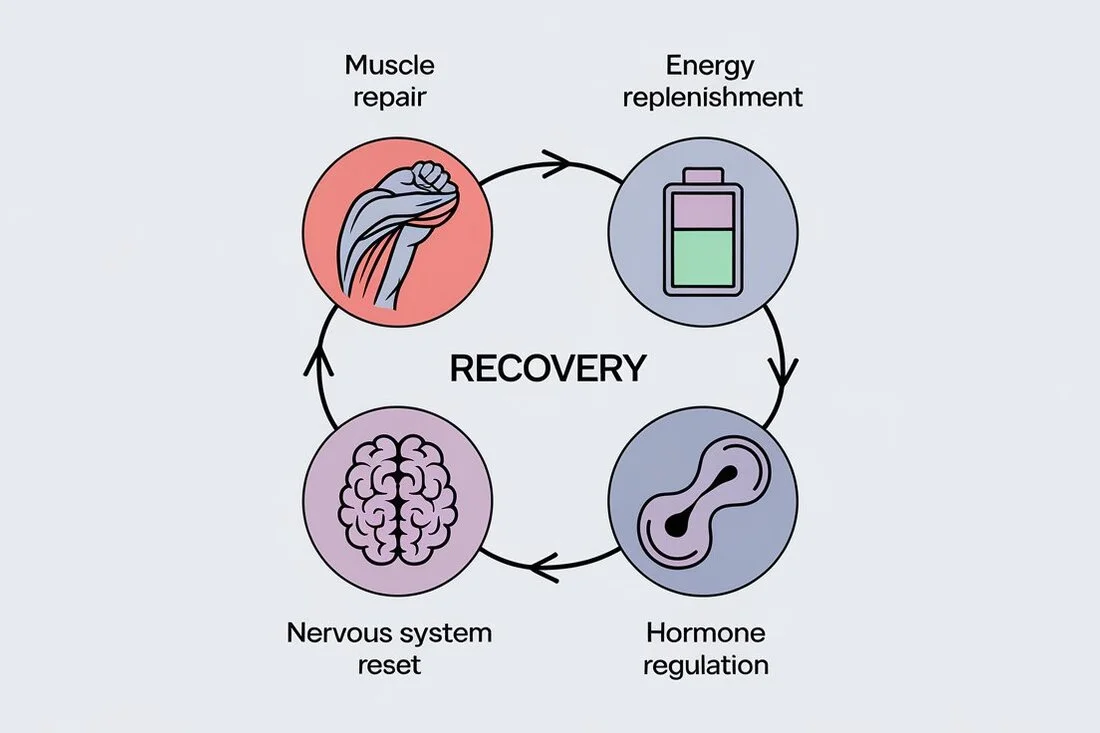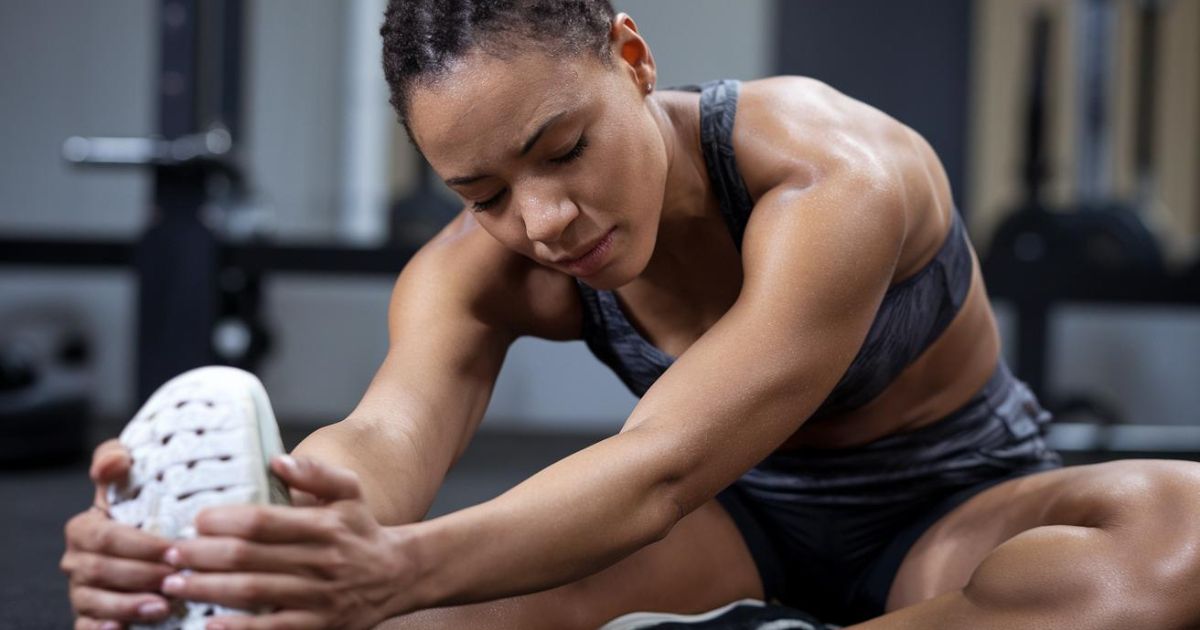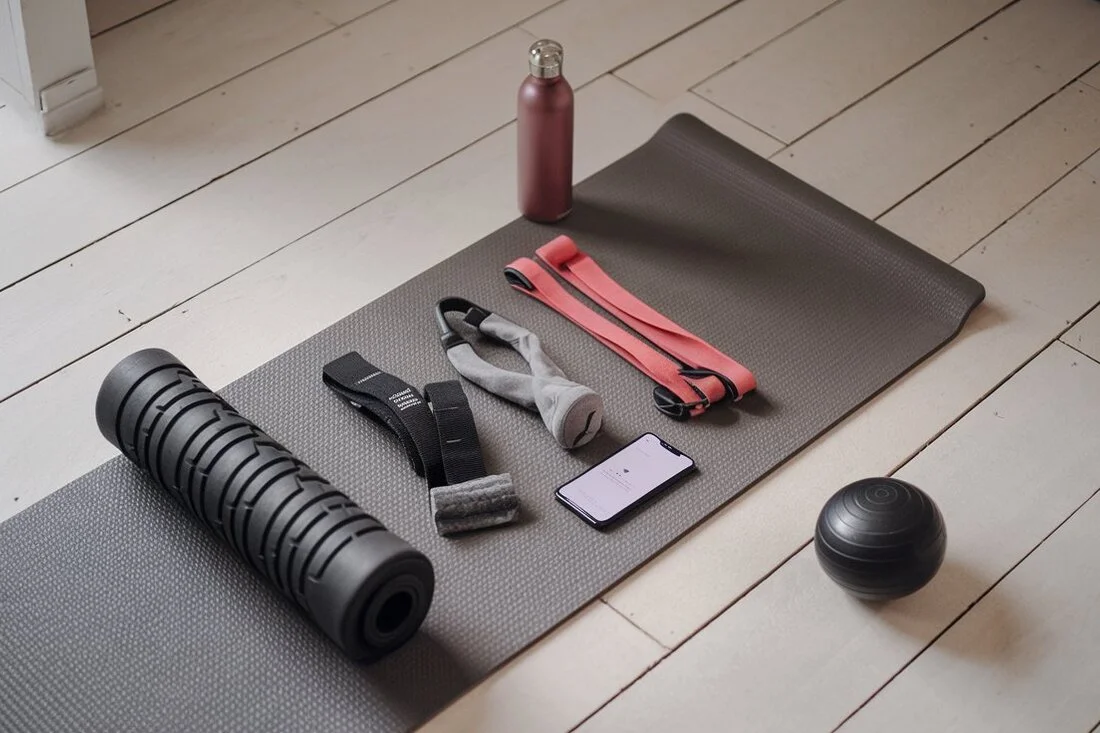For dedicated home athletes, optimizing home athletes recovery is just as crucial as crushing a challenging workout.
Yet, studies suggest that nearly 60% of home athletes experience performance plateaus or even injuries due to inadequate recovery strategies.
It’s easy to get caught up in the excitement of training at home, pushing limits within our personal spaces. However, without proper recovery, those limits quickly turn into roadblocks.

Home athletes often face unique challenges—limited space, budget constraints on equipment, and perhaps less access to professional guidance.
But what if you could access the same recovery secrets used by elite athletes, right from the comfort of your own home?
This is where we bridge the gap. Here we will equip you with pro-level recovery techniques adapted for your home environment.
From optimizing nutrition and mastering active recovery to prioritizing sleep and mastering simple self-care techniques, consider this your playbook for unlocking peak performance and a stronger, healthier you.
Understanding Recovery – Why It’s Crucial for Home Athletes

Recovery is far more than just taking a day off from your workouts. It’s an active process that allows your body to adapt to the stress of exercise, repair itself, and come back stronger.
For home athletes, understanding and implementing proper recovery strategies is crucial for long-term success and overall well-being.
What is Recovery?
Recovery in the context of athletics refers to the multi-faceted process of restoring the body to its pre-exercise state and adapting to the stresses placed upon it during training.
It encompasses physical rest, but also includes nutrition, hydration, sleep, and mental relaxation.
Think of recovery as the bridge between your workouts – it’s what allows you to consistently perform at your best and make progress over time.
The Science of Recovery
During recovery, your body undergoes several important physiological processes:
- Muscle Repair: Intense exercise causes micro-tears in muscle fibers. During recovery, your body repairs these tears, resulting in stronger, more resilient muscles.
- Energy Replenishment: Your body restores glycogen (stored carbohydrates) in muscles and the liver, which is crucial for future workouts.
- Hormone Regulation: Recovery allows for the normalization of stress hormones like cortisol and the production of growth hormone, which is essential for muscle development and repair.
- Nervous System Reset: Your central nervous system needs time to recover from the demands of intense exercise, allowing for better muscle recruitment and coordination in future workouts.

Benefits of Proper Recovery
Implementing effective recovery strategies can lead to numerous benefits for home athletes:
- Improved Performance: Proper recovery allows you to train more consistently and at a higher intensity, leading to better overall performance.
- Injury Prevention: Giving your body adequate time to repair and adapt reduces the risk of overuse injuries and burnout.
- Reduced Muscle Soreness: Effective recovery techniques can minimize delayed onset muscle soreness (DOMS), allowing you to feel fresher for your next workout.
- Faster Adaptation: Recovery is when your body adapts to the stress of exercise. Proper recovery enhances this process, leading to faster strength and endurance gains.
- Enhanced Mental Well-being: Recovery practices often include stress-reduction techniques, which can improve mood, focus, and overall mental health.
Key Takeaway – Prioritizing recovery is not a luxury or a sign of weakness – it’s an essential component of any successful training program.
By giving recovery the same attention you give to your workouts, you’re setting yourself up for consistent progress, reduced injury risk, and a more enjoyable fitness journey.
Remember, it’s during recovery that your body adapts and grows stronger. Embrace it as a crucial part of your athletic development.
Professional Recovery Techniques Adapted For Home Use
You don’t need a fancy gym or a team of specialists to recover like a pro. Many techniques used by elite athletes can be easily incorporated into your home routine:
Cold Water Immersion (Ice Baths at Home)

- Benefits: Cold water immersion, often in the form of ice baths, is a powerful tool for reducing inflammation and muscle soreness. It constricts blood vessels, reducing swelling, and flushes metabolic waste from tissues.
- DIY Instructions:
- Fill Your Tub: Add cold water and gradually incorporate ice (if using) to reach a temperature of 50-59°F (10-15°C).
- Ease In: Submerge yourself for 10-15 minutes. It’s normal to feel cold at first!
- Listen to Your Body: Don’t push past discomfort, and consult your doctor if you have any underlying health concerns.
- Addressing Concerns:
- Too Cold? Start with shorter durations and gradually increase your time as you adapt.
- Limited Space? A cold shower for a few minutes can also provide benefits.
Active Recovery Workouts

- Benefits: Low-intensity exercise after strenuous workouts increases blood flow, delivering nutrients to muscles and aiding in waste removal.
- Workout Examples:
- Light Cardio: Easy jogging, cycling, swimming, or even brisk walking for 20-30 minutes.
- Yoga or Pilates: Focus on gentle flows and poses that promote flexibility and blood flow.
- Key Point: Keep the intensity low enough that you can hold a conversation comfortably.
Self-Myofascial Release (Foam Rolling)

- Benefits: Foam rolling helps release muscle knots (trigger points), improves flexibility, and increases blood flow to muscles, aiding in recovery.
- Technique: Apply gentle pressure to tight areas and roll slowly back and forth for 30-60 seconds.
- Choosing Tools:
- High-Density Foam Roller: Best for beginners or those with less sensitivity.
- Textured Roller: Provides more targeted pressure for deeper tissue release.
- Massage Balls: Ideal for specific trigger points, like the glutes or feet.
Stretching and Mobility Work

- Benefits: Flexibility is key for injury prevention and efficient movement. Stretching post-workout helps maintain range of motion and reduce stiffness.
- Targeted Stretches:
- Hamstring Stretch: Sit with legs extended and reach towards your toes.
- Quadriceps Stretch: Standing, grab one foot and gently pull towards your glutes.
- Chest Opener: Interlock fingers behind your back and lift your arms, feeling a stretch in your chest and shoulders.
- Hip Flexor Stretch: Kneel with one leg forward and gently push your hips forward, feeling a stretch in the front of your hip.
- Key Point: Hold stretches for 30 seconds, focusing on deep breathing, and never force your body into a painful position.
Key Takeaway – Integrating these professional-grade recovery techniques into your home routine is easier than you think.
By taking a proactive approach to recovery, you can experience faster progress, reduced muscle soreness, and fewer setbacks on your fitness journey.
DIY Recovery Methods for Home Athletes
Beyond specialized techniques, simple lifestyle choices can dramatically impact how effectively you recover at home.
Here’s how to optimize your daily routine for better athletic performance:
Sleep Optimization – Your Body’s Built-In Repair Shop

- Why Sleep Matters: During sleep, your body releases growth hormone, repairs muscle tissue, rebuilds energy stores, and consolidates memory (including muscle memory!). Inadequate sleep can hinder all these processes, leading to decreased performance, increased injury risk, and reduced motivation.
- Actionable Tips for Better Sleep Hygiene:
- Consistency is Key: Aim for 7-9 hours of quality sleep each night and try to go to bed and wake up around the same time, even on weekends, to regulate your body’s natural sleep-wake cycle.
- Create a Relaxing Bedtime Routine: Take a warm bath, read a book, or practice relaxation techniques like deep breathing to signal to your body that it’s time to wind down.
- Optimize Your Sleep Environment: Ensure your bedroom is dark, quiet, and cool for optimal sleep.
- Limit Screen Time Before Bed: The blue light emitted from electronic devices can interfere with melatonin production, a hormone that regulates sleep. Aim to disconnect from screens at least an hour before bed.
- Avoid Caffeine and Alcohol Before Bed: These substances can disrupt sleep patterns and prevent restful sleep.
Hydration Strategies – Replenish and Rejuvenate

- Importance of Hydration: Water is essential for countless bodily functions, including nutrient transport, waste removal, temperature regulation, and joint lubrication. Dehydration can lead to muscle cramps, fatigue, dizziness, and hinder overall recovery.
- Practical Tips for Staying Hydrated:
- Carry a Water Bottle: Make it a habit to have water with you throughout the day, especially during and after workouts.
- Monitor Your Urine Color: Aim for a pale yellow color, which indicates adequate hydration.
- Hydrate Before, During, and After Workouts: Don’t wait until you’re thirsty to drink water, especially during intense training sessions.
- Consider Electrolyte Drinks: For particularly strenuous or long workouts, sports drinks containing electrolytes can help replenish lost fluids and minerals.
Nutrition for Recovery – Fuel Your Body for Peak Performance

- Macronutrients Matter:
- Protein: Essential for muscle repair and growth. Include protein-rich foods like lean meats, poultry, fish, beans, lentils, tofu, eggs, and Greek yogurt in your diet.
- Carbohydrates: Replenish glycogen stores, providing energy for your next workout. Opt for complex carbs like whole grains, fruits, and vegetables.
- Healthy Fats: Support hormone production and overall cell function. Include sources like avocado, nuts, seeds, and olive oil.
- Micronutrient Power:
- Focus on Antioxidants: Colorful fruits and vegetables are packed with antioxidants that combat exercise-induced oxidative stress and inflammation.
- Recovery-Boosting Foods:
- Tart Cherry Juice: Contains antioxidants that may reduce muscle soreness and inflammation.
- Watermelon: High in L-citrulline, which may improve blood flow and reduce muscle fatigue.
- Fatty Fish (Salmon, Tuna, Mackerel): Rich in omega-3 fatty acids, which possess anti-inflammatory properties.
Stress Management – Calm Your Mind, Restore Your Body

- The Stress-Recovery Connection: Chronic stress elevates cortisol levels, which can interfere with muscle repair, sleep quality, and increase the risk of injury.
- Simple Stress-Reduction Techniques:
- Meditation or Mindfulness: Even a few minutes of daily meditation can calm the nervous system and reduce stress hormones.
- Deep Breathing Exercises: Practice diaphragmatic breathing (breathing deeply into your belly) to activate the body’s relaxation response.
- Yoga or Tai Chi: These practices combine movement, deep breathing, and mindfulness to reduce stress and improve flexibility.
- Spend Time in Nature: Research shows that spending time outdoors can reduce stress levels and improve mood.
Key Takeaway – These DIY recovery methods are accessible to everyone. By optimizing your sleep, hydration, nutrition, and stress management, you’ll create a powerful foundation for enhanced recovery, improved performance, and a healthier approach to your home workouts.
Tools and Equipment Recommendations

Investing in the right recovery tools doesn’t have to drain your bank account. Here’s a range of options to suit various budgets and needs:
Budget-Friendly Essentials – Simple Yet Effective
- Foam Roller: A must-have for any home athlete. Use it for self-myofascial release to target tight muscles, improve flexibility, and increase blood flow.
- Price Range: $10 – $30
- Resistance Bands: Versatile tools for stretching, mobility work, and light resistance training, aiding in muscle activation and recovery.
- Price Range: $5 – $20
- Massage Balls: Target specific trigger points for deep tissue release, particularly helpful for plantar fasciitis or tight glutes.
- Price Range: $5 – $15
Tech Options – Harnessing Technology for Recovery
- Guided Meditation Apps (Headspace, Calm, Insight Timer): Reduce stress, improve sleep quality, and enhance mental clarity with guided meditations.
- Price Range: Many offer free versions or trials; subscriptions vary.
- Sleep Tracking Apps (Sleep Cycle, SleepScore, Fitbit): Track sleep patterns, identify sleep disturbances, and optimize sleep hygiene based on personalized insights.
- Price Range: Many free apps available; some offer premium features for a fee.
- Workout Recovery Tracking Apps (WHOOP, Oura Ring): Monitor metrics like heart rate variability, sleep stages, and respiratory rate to assess recovery levels and optimize training schedules.
- Price Range: Typically require a subscription or membership; some involve purchasing a wearable device.
Optional Investments – High-Tech Tools for Enhanced Recovery
- Massage Guns (Theragun, Hypervolt): Percussive therapy can help relieve muscle soreness, reduce tension, and improve range of motion.
- Pros: Convenient and effective for deep tissue massage.
- Cons: Can be expensive and noisy.
- Price Range: $100 – $600+
- Compression Boots (Normatec, Air Relax): Use air compression to improve blood circulation, reduce swelling, and flush metabolic waste from the legs.
- Pros: Can be helpful for athletes with heavy leg fatigue or those prone to swelling.
- Cons: Bulky, expensive, and may not be suitable for everyone.
- Price Range: $300 – $1000+
Key Takeaway – Building a home recovery toolkit doesn’t have to be expensive. Start with the basics like foam rollers and resistance bands, and then consider gradually incorporating tech or higher-end tools based on your budget, needs, and preferences.
Remember, even small investments in recovery can yield significant results.
Case Studies or Success Stories – Home Athletes, Pro Recovery
These stories illustrate how everyday individuals have transformed their recovery and performance through the power of home-based techniques:
1. Sarah, the Busy Mom Who Conquered Marathon Training Fatigue
Sarah, a working mother of two, always dreamed of running a marathon. Juggling family life and a demanding job, finding time for training was tough enough – but she constantly hit a wall due to fatigue. Enter the power of recovery! Sarah began prioritizing sleep, aiming for 8 hours a night, and incorporating Epsom salt baths (a budget-friendly DIY recovery method!) twice a week to ease sore muscles. She also started using a foam roller to target tight hips and IT bands. The result? Sarah not only finished her first marathon but smashed her personal goal, feeling strong and energized throughout her training.
2. Michael, the Weekend Warrior Who Overcame Recurring Back Pain
Michael, an avid hiker and weekend basketball player, battled chronic lower back pain that hindered his active lifestyle. He thought stretching was enough, but then he discovered the power of self-myofascial release. He started using a lacrosse ball to target specific trigger points in his glutes and hip flexors, combined with daily mobility work. To his surprise, his back pain significantly decreased, and his hiking endurance and basketball performance improved. He even noticed better posture throughout the day!
3. Maria, the Yoga Enthusiast Who Boosted Flexibility and Reduced Stress
Maria loved her yoga practice but felt limited by tight hamstrings and hip flexors. She also struggled to manage stress after long workdays. Incorporating regular foam rolling, targeted stretching, and a simple evening meditation routine transformed her practice and well-being. She noticed significant improvements in her flexibility, allowing her to access deeper poses with more ease. The meditation helped quiet her mind and transition from work to relaxation, leading to better sleep and reduced stress.
Key Takeaway – These real-life examples demonstrate that achieving pro-level recovery is within everyone’s reach.
Whether you’re training for a marathon, managing chronic pain, or simply striving to improve your fitness, incorporating effective recovery techniques into your home routine can lead to remarkable transformations.
Expert Interviews – Insights from the Pros
To give you even more insider knowledge, we sought advice from leading fitness professionals. Here’s what they recommend for home athletes:
Designing Effective Home Recovery Routines:
Meet Coach James, a certified personal trainer with over 10 years of experience:
“The biggest mistake I see home athletes make is neglecting recovery altogether or treating it as an afterthought. Recovery needs to be planned just like your workouts!” – Coach James
Coach James’ Top Tip: “Create a weekly recovery schedule. For example, after a hard leg day, plan for a light swim or an extended foam rolling session. This proactive approach keeps you consistent and helps prevent those little niggles from becoming major setbacks.”
Optimizing Nutrition for Recovery:
We spoke to Emily, a registered sports nutritionist:
“Recovery nutrition doesn’t have to be complicated. Start by focusing on hydration and consuming a balanced meal or snack containing protein and carbohydrates within 30-60 minutes of your workout.” – Emily
Emily’s Pro Tip: “A smoothie with Greek yogurt, berries, and a handful of spinach is a quick and easy post-workout option that’s packed with nutrients to support recovery.”
Injury Prevention and Management at Home:
We interviewed Dr. Lisa, a licensed physical therapist:
“Home athletes often push themselves without the same level of supervision they might receive in a gym. This makes listening to your body even more critical.” – Dr. Lisa
Dr. Lisa’s Advice: “Don’t ignore pain. Early intervention is key. If you experience persistent discomfort, consult with a healthcare professional. In the meantime, RICE (rest, ice, compression, elevation) can be helpful for acute injuries.”
Key Takeaway – These expert insights underscore the importance of a well-rounded approach to recovery, encompassing planned routines, proper nutrition, and proactive injury management. By integrating the advice of these professionals, you can maximize your body’s ability to recover, rebuild, and thrive.
FAQs – Your Home Athlete Recovery Questions, Answered
We’ve addressed some common questions about recovery to clear up any confusion and help you optimize your routine:
1. I’m not a pro athlete – do I really need to worry about recovery?
Absolutely! Recovery is essential for everyone who exercises, regardless of fitness level. It allows your body to repair, rebuild, and adapt to the stress of workouts, preventing injury and improving performance.
2. How often should I be incorporating recovery techniques?
This depends on your training frequency, intensity, and individual needs. For active individuals, aim for at least one recovery-focused activity each day. After particularly challenging workouts, dedicate more time to recovery techniques.
3. I’m new to exercise. Which recovery techniques are best for beginners?
Start with the basics:
- Hydrate well: Aim for half your body weight in ounces of water per day.
- Prioritize sleep: Aim for 7-9 hours each night.
- Gentle stretching: Hold stretches for 15-30 seconds after workouts.
- Walking: Incorporate light walks on rest days for active recovery.
4. I’m short on time. What’s the most efficient recovery method?
Even 10 minutes of foam rolling or gentle stretching before bed can make a difference. Other time-saving options include listening to a guided meditation while commuting or enjoying a quick Epsom salt bath.
5. How do I know if I’m recovered enough to work out again?
Pay attention to your body. If you’re experiencing muscle soreness that limits your range of motion or unusual fatigue, take an extra rest day. Don’t push through pain, as it could lead to injury.
6. Are there any recovery techniques I should avoid?
It’s best to avoid activities that put excessive stress on your body when you’re trying to recover. These may include:
- Intense exercise too soon after a hard workout
- Heavy alcohol consumption
- Consuming large amounts of processed foods, as these can increase inflammation
7. I have a specific injury. Which recovery techniques are safe for me?
It’s crucial to consult with a healthcare professional or physical therapist for guidance on recovery from specific injuries. They can recommend appropriate exercises and techniques that won’t aggravate your condition.
We hope these FAQs have addressed some of your recovery questions! Remember, prioritizing your recovery is a vital part of a sustainable and successful fitness journey.
Conclusion – Recover Smarter, Train Harder, Achieve More
As we’ve explored throughout this guide, recovery isn’t a luxury for the elite athlete – it’s the secret weapon for every home athlete who seeks consistent progress, fewer injuries, and a deeper connection with their body.
By prioritizing recovery, you’re not hitting the pause button on your fitness journey; you’re investing in its longevity. Remember:
- Recovery fuels performance: Adequate rest, replenishment, and rejuvenation allow you to train harder and smarter.
- Recovery mitigates injury risk: Addressing muscle soreness, tightness, and fatigue reduces the likelihood of setbacks.
- Recovery enhances overall well-being: A holistic approach to recovery benefits not just your physical health but also your mental focus and energy levels.
You now have the knowledge, techniques, and expert advice to transform your approach to recovery. But knowledge without action is like a car without fuel – it won’t get you very far!
Ready to experience the difference that smart recovery can make?
Choose one technique from this guide that resonates with you. Perhaps it’s dedicating 30 minutes to a hot Epsom salt bath, trying out a new foam rolling routine, or simply prioritizing 8 hours of quality sleep tonight.
Share your experience in the comments below! We’d love to hear which recovery techniques you’re implementing and how they’re impacting your training and overall well-being.
Let’s build a community of home athletes who are committed to recovering as effectively as they train!
Related Posts
No posts
